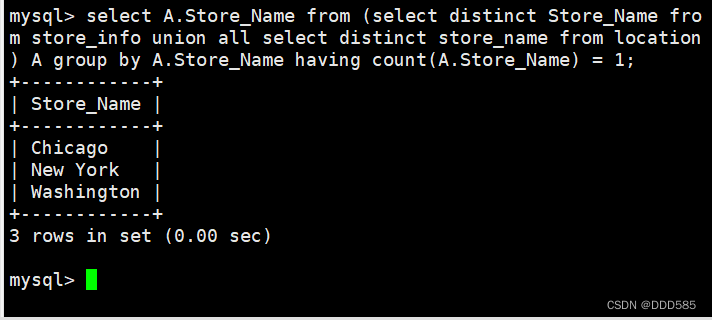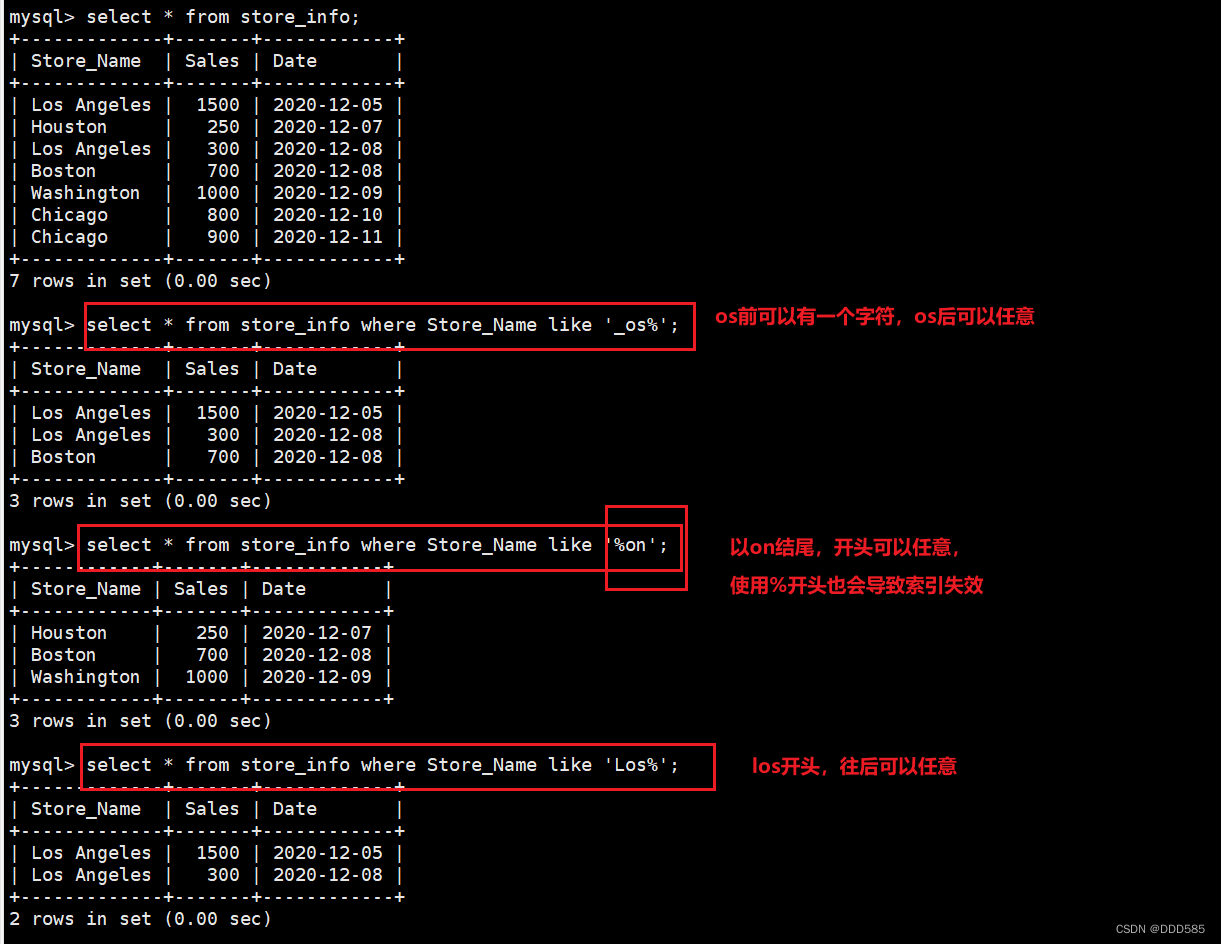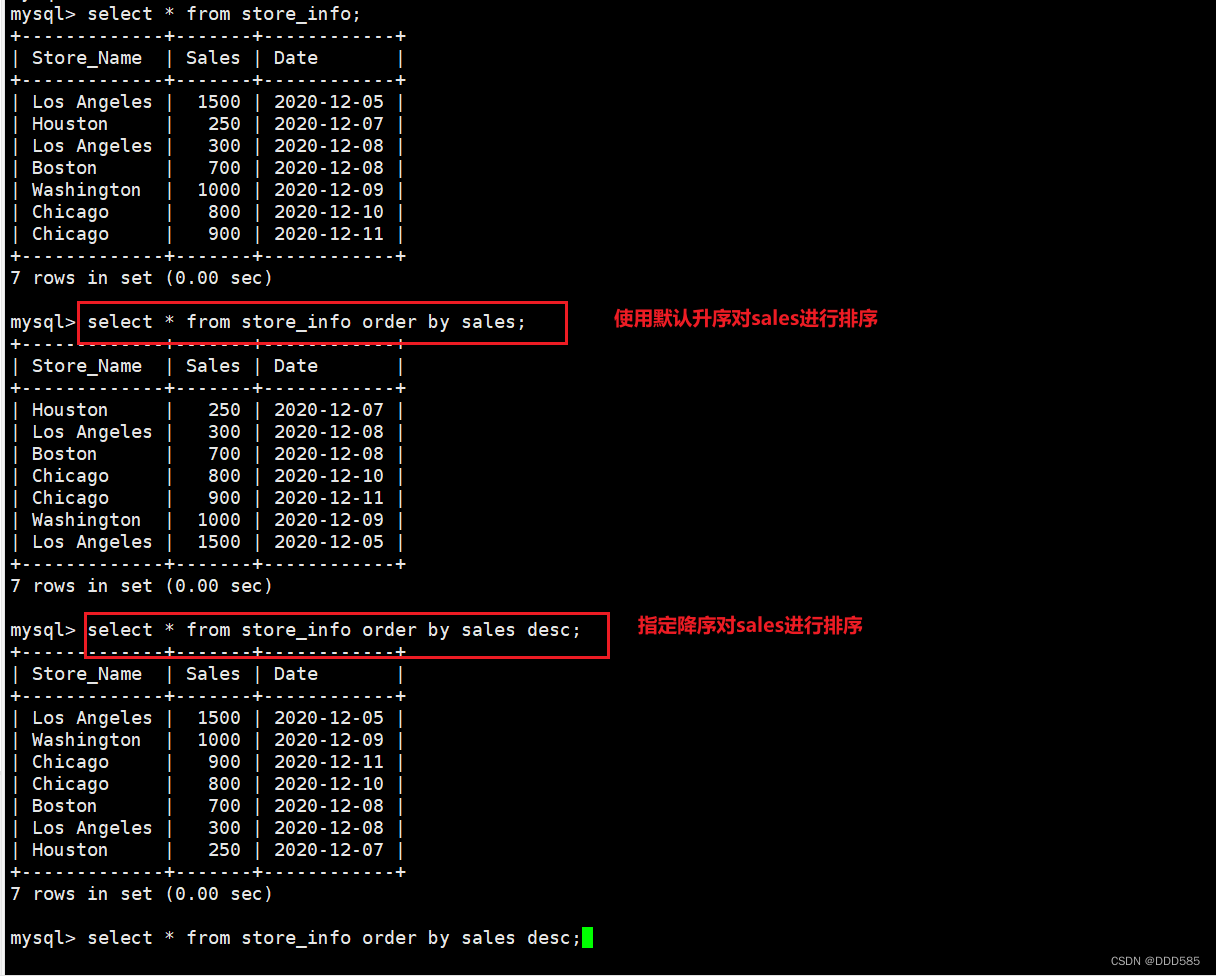目录
[1.1 select](#1.1 select)
[1.2 distinct](#1.2 distinct)
[1.3 where](#1.3 where)
[1.4 and or](#1.4 and or)
[1.5 in](#1.5 in)
[1.6 between](#1.6 between)
[1.7 通配符](#1.7 通配符)
[1.8 like](#1.8 like)
[1.9 ORDER BY](#1.9 ORDER BY)
[2.1 数学函数](#2.1 数学函数)
[2.2 聚合函数](#2.2 聚合函数)
[2.3 字符串函数](#2.3 字符串函数)
[2.3.1 upper、lower大小写转换](#2.3.1 upper、lower大小写转换)
[2.3.2 concat拼接](#2.3.2 concat拼接)
[2.3.3 substr字符串截取](#2.3.3 substr字符串截取)
[2.3.3 length长度查看](#2.3.3 length长度查看)
[2.3.3 replace替换](#2.3.3 replace替换)
[2.3.3 trim移除](#2.3.3 trim移除)
[3.1 group by汇总](#3.1 group by汇总)
[3.2 having](#3.2 having)
[3.3 别名](#3.3 别名)
[3.4 子查询](#3.4 子查询)
[3.5 exists(类查询)](#3.5 exists(类查询))
[4.1 表连接](#4.1 表连接)
[4.2 内连接](#4.2 内连接)
[4.3 左连接](#4.3 左连接)
[4.3 右连接](#4.3 右连接)
[5.1 交集方法](#5.1 交集方法)
[5.2 求无交集方法总结](#5.2 求无交集方法总结)
1.MySQL进阶查询
数据库实例准备:
create database tan;
use tan;
###在数据库tan中创建数据表location,并添加数据记录
create table location (Region char(20),Store_Name char(20));
insert into location values('East','Boston');
insert into location values('East','New York');
insert into location values('West','Los Angeles');
insert into location values('West','Houston');
###在数据库tan中创建数据表store_info,并添加数据记录
create table store_info (Store_Name char(20),Sales int(10),Date char(10));
insert into store_info values('Los Angeles','1500','2020-12-05');
insert into store_info values('Houston','250','2020-12-07');
insert into store_info values('Los Angeles','300','2020-12-08');
insert into store_info values('Boston','700','2020-12-08');
insert into store_info values('Washington','1000','2020-12-09');
insert into store_info values('Chicago','800','2020-12-10');1.1 select
select:显示表格中一个或数个字段的所有数据记录
语法:SELECT "字段" FROM "表名";
select store_name from store_info;1.2 distinct
distinct:不显示重复的数据记录
语法:SELECT DISTINCT "字段" FROM "表名";
select distinct Store_Name from store_info;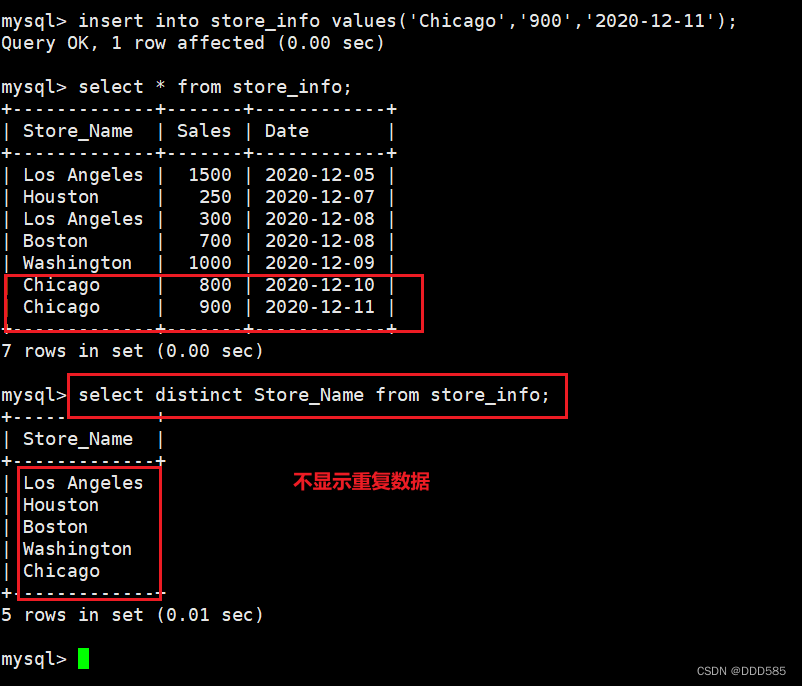
1.3 where
where:有条件查询
语法:SELECT "字段" FROM "表名" WHERE "条件";
select * from store_info where Store_Name = 'Los Angeles';
select * from store_info where Store_Name != 'Los Angeles';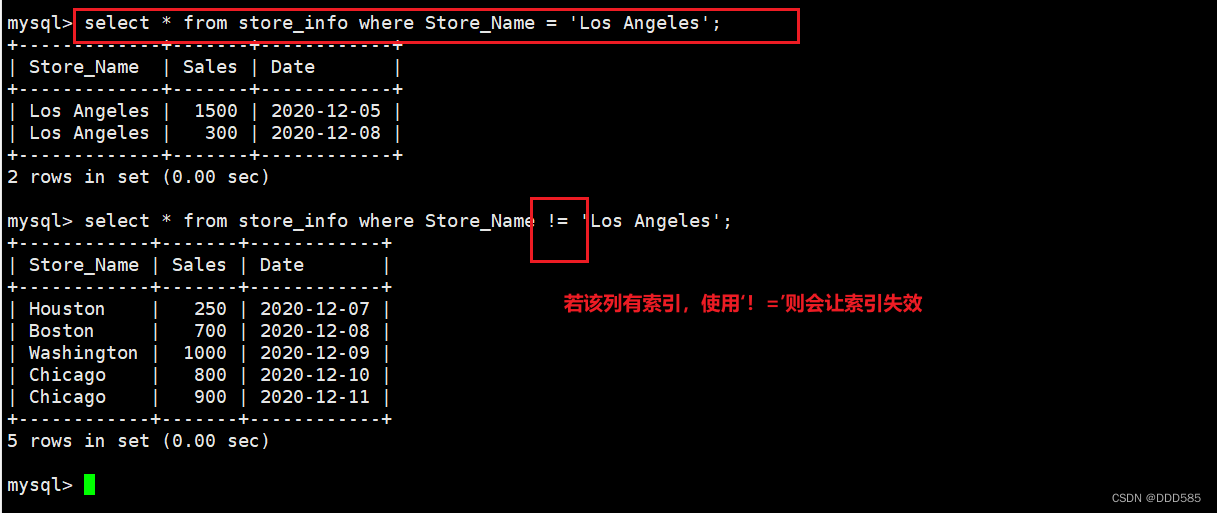
1.4 and or
and or:且 或
语法:SELECT "字段" FROM "表名" WHERE "条件1" {[AND|OR] "条件2"}+ ;
select * from store_info where Sales >= 700 and Sales <= 900;
select * from store_info where Store_Name='Los Angeles' or Store_Name = 'Houston';
mysql> select * from store_info where (Store_Name='Los Angeles' or Store_Name = 'Houston') and sales > 1000;


1.5 in
in:显示已知的值的数据记录
语法:SELECT "字段" FROM "表名" WHERE "字段" IN ('值1', '值2', ...);
select * from store_info where Sales in (1500, 250);
等于
select * from store_info where sales=1500 or sales=250;
select * from store_info where Sales not in (1500, 250);
等于
select * from store_info where sales!=1500 and sales!=250;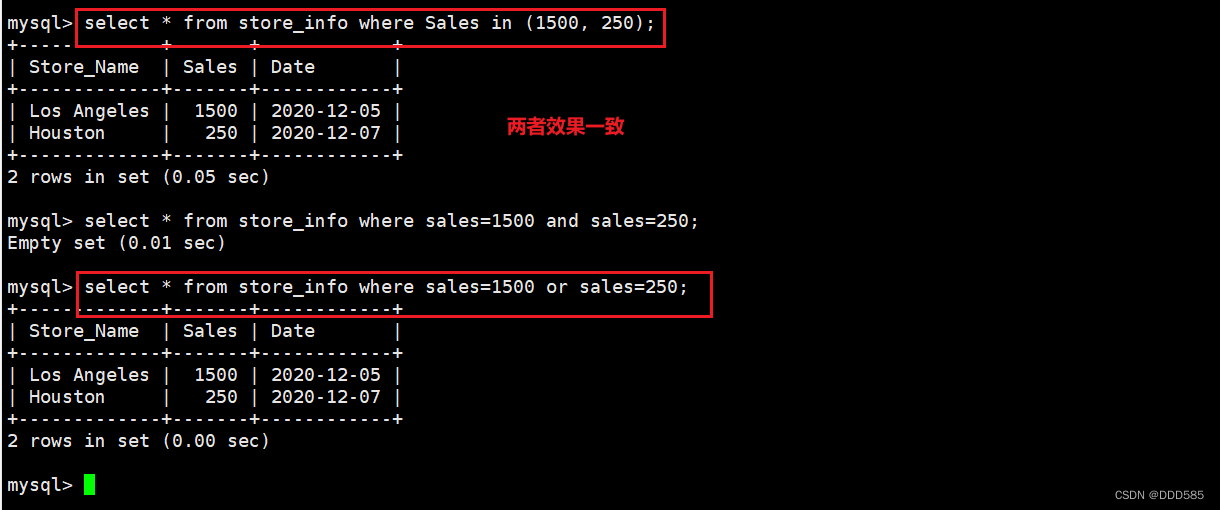
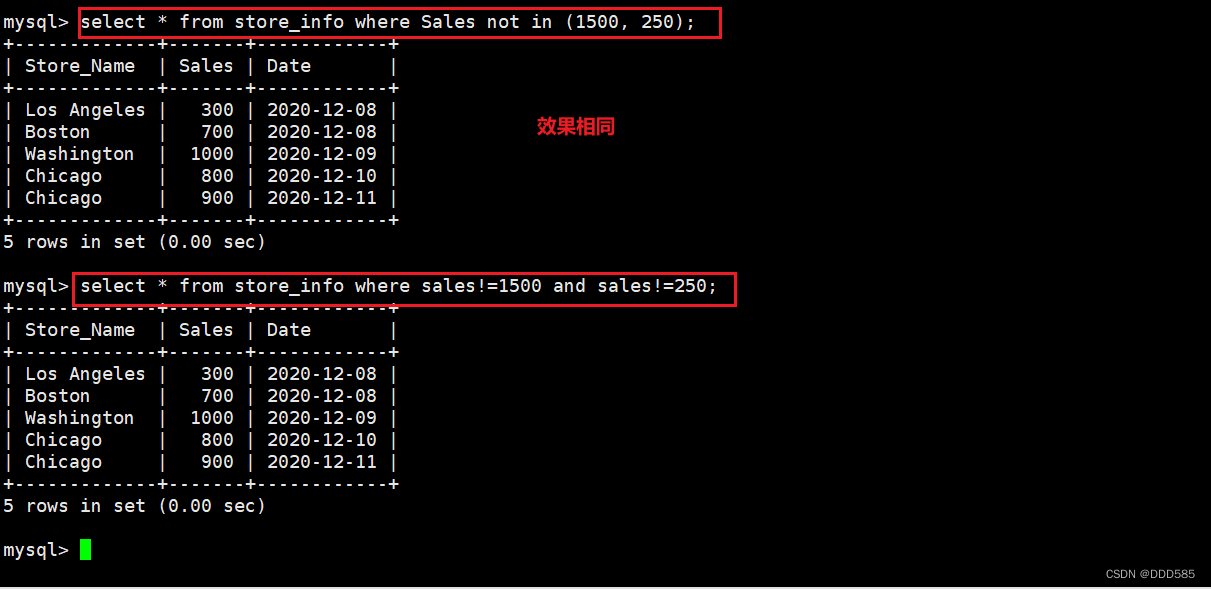
1.6 between
between:显示两个值范围内的数据记录
语法:SELECT "字段" FROM "表名" WHERE "字段" BETWEEN '值1' AND '值2';
select * from store_info where date between '2020-12-05' and '2020-12-08';
等于
select * from store_info where date >='2020-12-05' and date<='2020-12-08';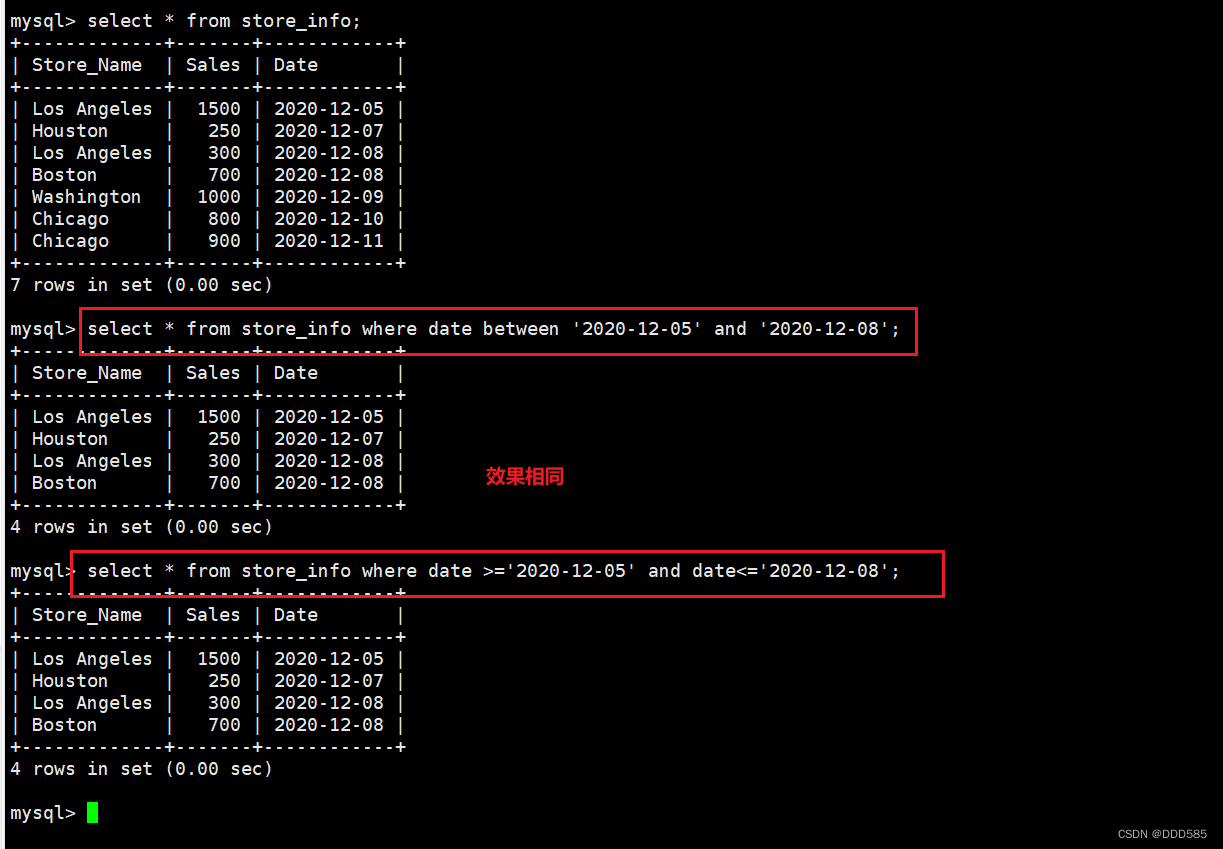
1.7 通配符
通配符:通常通配符都是跟like一起使用的
% :百分号表示零个、一个或多个字符
_ :下划线表示单个字符
'A_Z':所有以 'A' 起头,另一个任何值的字符,且以'Z'为结尾的字符串。例如,'ABZ' 和 'A2Z' 都符合这一个模式,而 'AKKZ' 并不符合 (因为在A和Z之间有两个字符,而不是一个字符)。
'ABC%': 所有以 'ABC' 起头的字符串。例如,'ABCD' 和 'ABCABC' 都符合这个模式。
'%XYZ': 所有以 'XYZ' 结尾的字符串。例如,'WXYZ' 和 'ZZXYZ' 都符合这个模式。
'%AN%': 所有含有 'AN'这个模式的字符串。例如,'LOS ANGELES' 和 'SAN FRANCISCO' 都符合这个模式。
'_AN%':所有第二个字母为 'A' 和第三个字母为 'N' 的字符串。例如,'SAN FRANCISCO' 符合这个模式,而 'LOS ANGELES' 则不符合这个模式。
select * from store_info where Store_Name like '_os%';
select * from store_info where Store_Name like '%on';
select * from store_info where Store_Name like 'Los%';1.8 like
like:匹配一个模式来找出我们要的数据记录
语法:SELECT "字段" FROM "表名" WHERE "字段" LIKE {模式};
select * from store_info where store_name like '%on%';1.9 ORDER BY
ORDER BY 按关键字排序
语法:SELECT "字段" FROM "表名" [WHERE "条件"] ORDER BY "字段" [ASC, DESC];
#ASC 是按照升序进行排序的,是默认的排序方式。
#DESC 是按降序方式进行排序。
select * from store_info order by sales;
select * from store_info order by sales desc;
select * from store_info where Store_Name in ('Los Angeles', 'Chicago') order by sales desc;
2.MySQL数据库函数
2.1 数学函数
|-------------------------|---------------------------|
| 数学函数 | 作用 |
| abs(x) | 返回x的绝对值 |
| rand() | 返回0到1的随机数 |
| mod(x, y) | 返回x除以y以后的余数 |
| power(x, y) | 返回x的y次方 |
| round(x) | 返回离x最近的整数 |
| round(x, y) | 保留x的y位小数四舍五入后的值 |
| sqrt(x) | 返回x的平方根 |
| truncate(x, y) | 返回数字x截断为y位小数的值 #不四舍五入 |
| ceil(x) | 返回大于或等于x的最小整数 |
| floor(x) | 返回小于或等于x的最大整数 |
| greatest(x1,x2,...) | 返回集合中最大的值 |
| least(x1,x2,...) | 返回集合中最小的值 |
SELECT abs(-1), rand(), mod(5,3), power(2,3), round(1.89);
SELECT round(1.8937,3), truncate(1.235,2), ceil(5.2), floor(2.1), least(1.89,3,6.1,2.1);
2.2 聚合函数
|-------------|-----------------------|
| 关键字 | 作用 |
| avg() | 返回指定列的平均值 |
| count() | 返回指定列中非 NULL 值的个数 |
| min() | 返回指定列的最小值 |
| max() | 返回指定列的最大值 |
| sum(字段) | 返回指定列的所有值之和 |
###返回指定列sales的平均值
select avg(sales) from store_info;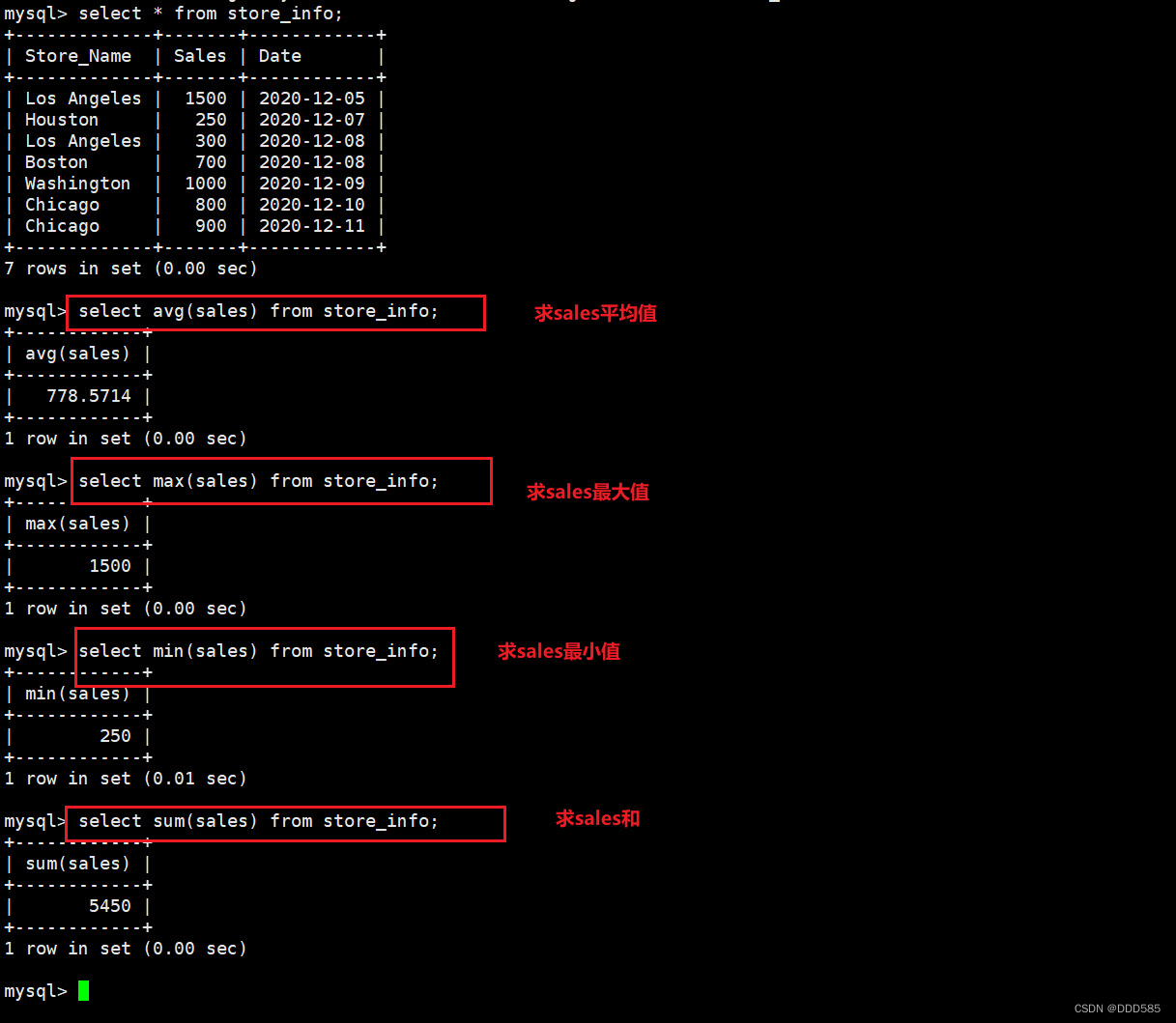
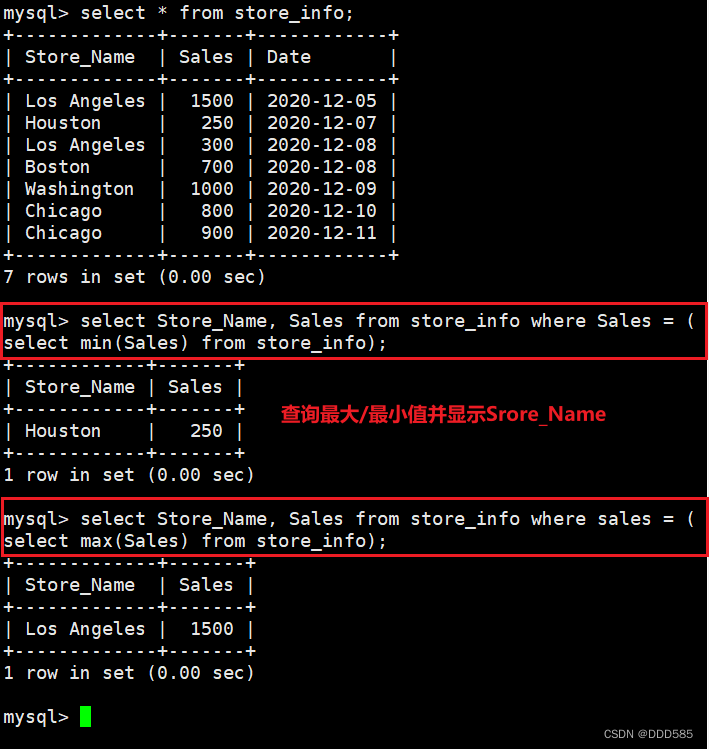
###返回指定列store_name列中非NULL值的个数
select count(store_name) from store_info;
select count(distinct store_name) from store_info;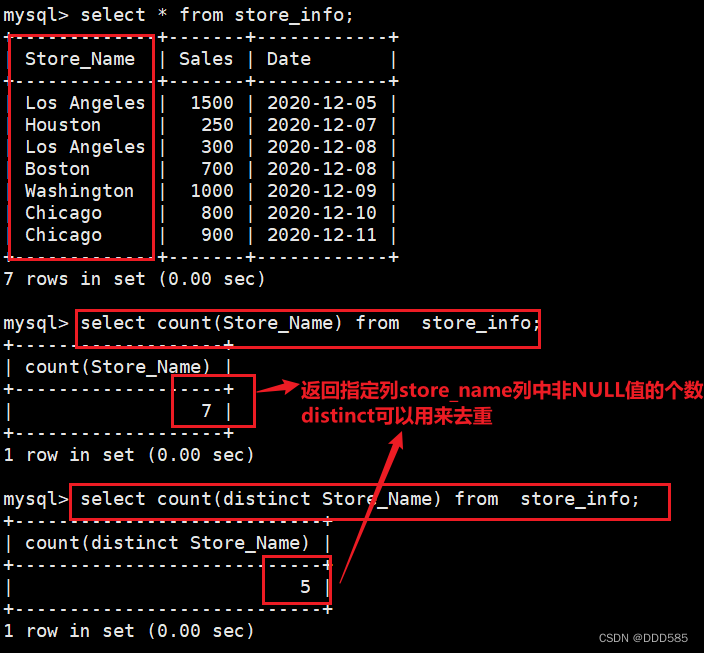
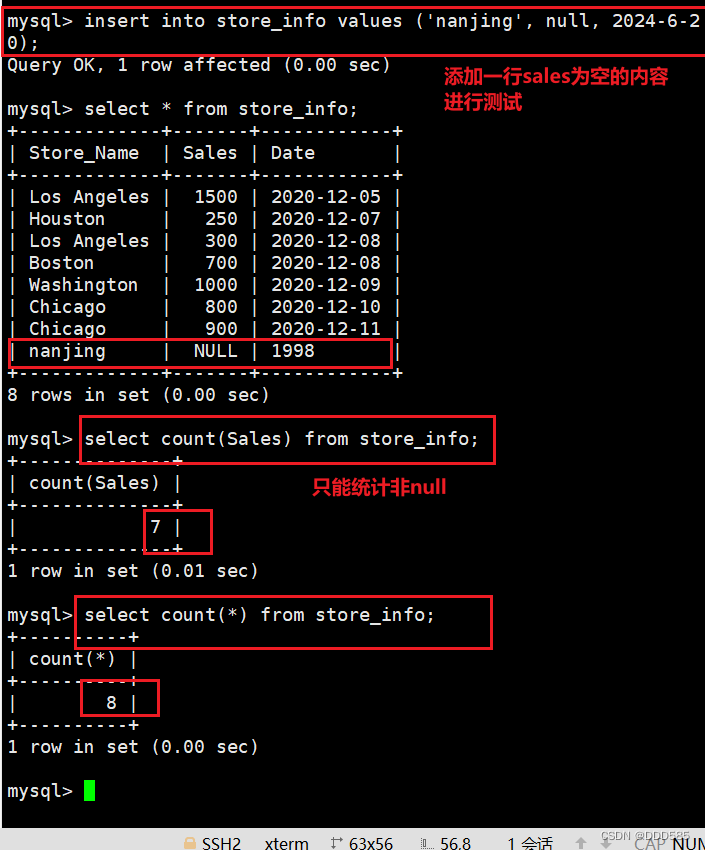
2.3 字符串函数
|--------------------|-------------------------------------------------|
| 字符串函数 | 作用 |
| trim() | 返回去除指定格式的值 |
| concat(x,y) | 将提供的参数 x 和 y 拼接成一个字符串 |
| substr(x,y) | 获取从字符串 x 中的第 y 个位置开始的字符串,跟substring()函数作用相同 |
| substr(x,y,z) | 获取从字符串 x 中的第 y 个位置开始长度为 z 的字符串 |
| length(x) | 返回字符串 x 的长度 |
| replace(x,y,z) | 将字符串 z 替代字符串 x 中的字符串 y |
| upper(x) | 将字符串 x 的所有字母变成大写字母 |
| lower(x) | 将字符串 x 的所有字母变成小写字母 |
| left(x,y) | 返回字符串 x 的前 y 个字符 |
| right(x,y) | 返回字符串 x 的后 y 个字符 |
| repeat(x,y) | 将字符串 x 重复 y 次 |
| space(x) | 返回 x 个空格 |
| strcmp(x,y) | 比较 x 和 y,返回的值可以为-1,0,1 |
| reverse(x) | 将字符串 x 反转 |
补充:字符串截取三种方法

2.3.1 upper、lower大小写转换
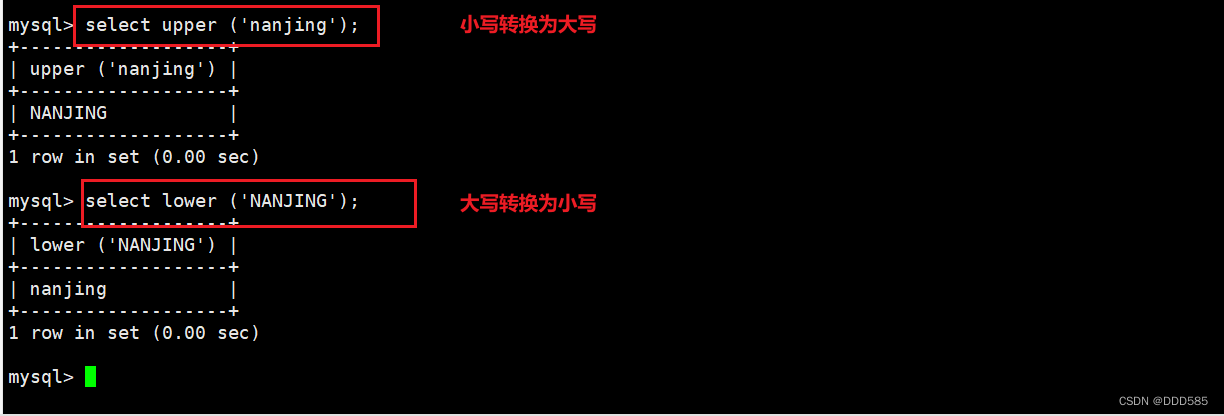
2.3.2 concat拼接

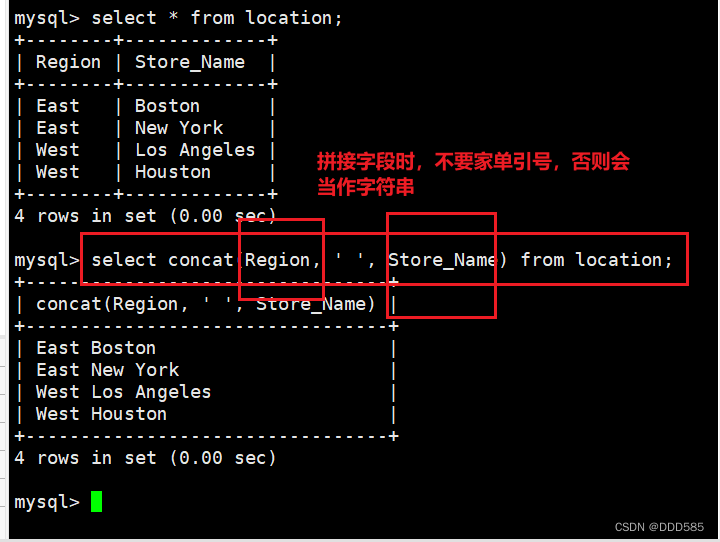
使用"||"进行拼接
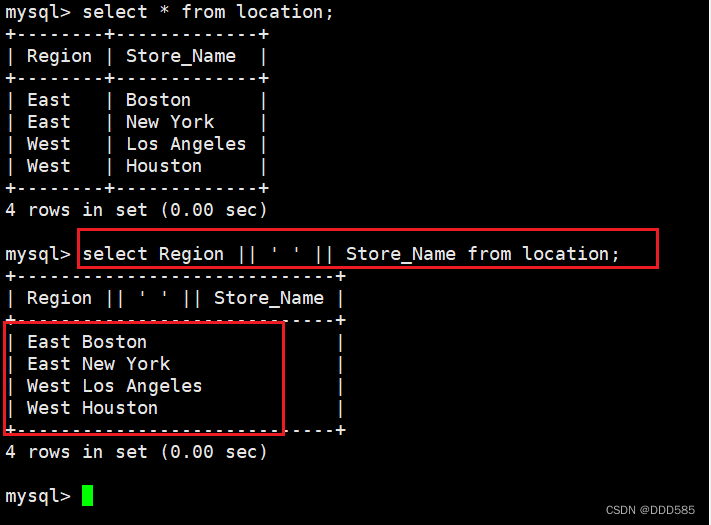
2.3.3 substr字符串截取

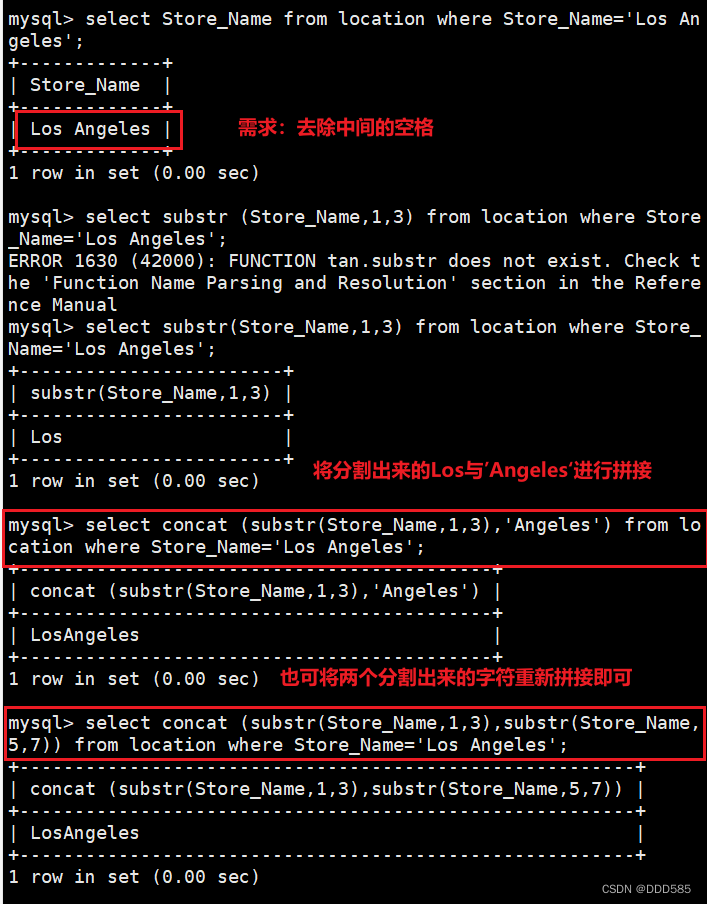
2.3.3 length长度查看
 2.3.3 replace替换
2.3.3 replace替换


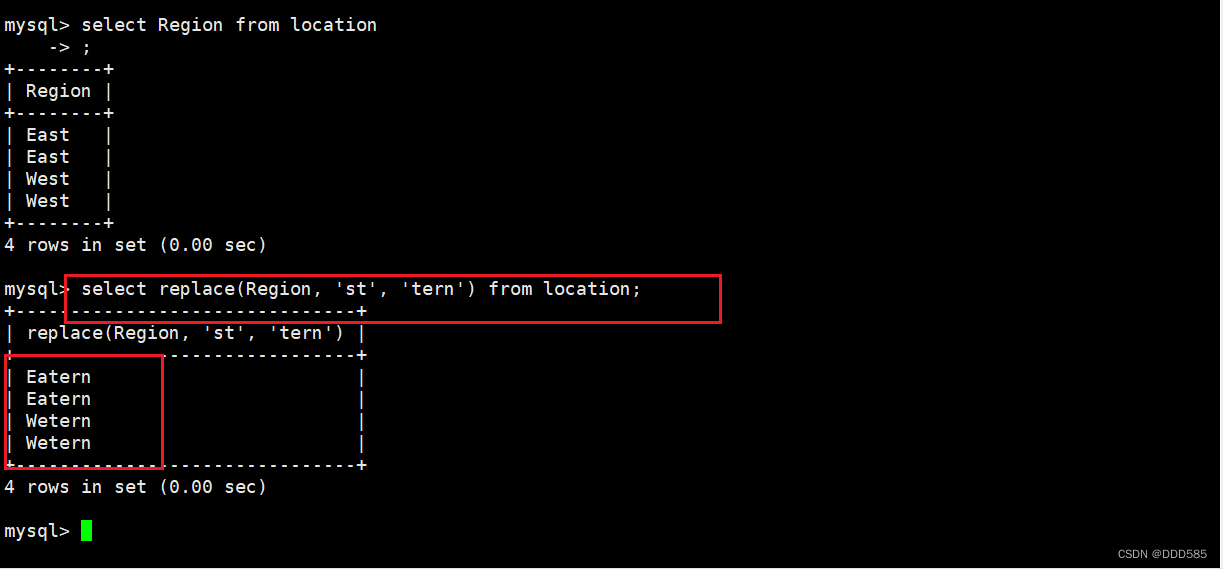
2.3.3 trim移除
SELECT TRIM ([ [位置] [要移除的字符串] FROM ] 字符串);
#[位置]:的值可以为 LEADING (起头), TRAILING (结尾), BOTH (起头及结尾)。
#[要移除的字符串]:从字串的起头、结尾,或起头及结尾移除的字符串。缺省时为空格。
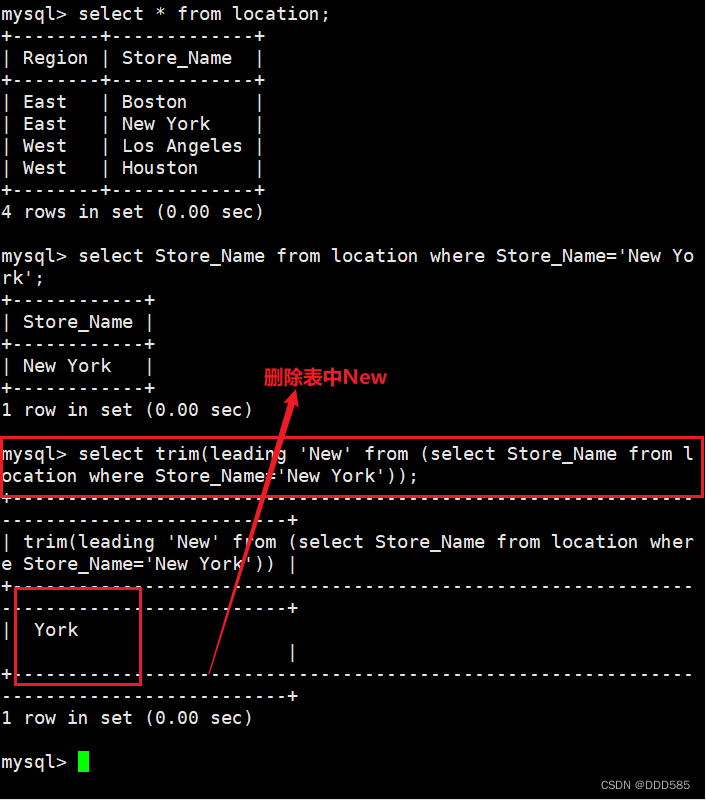
2.3.3 left、right取值
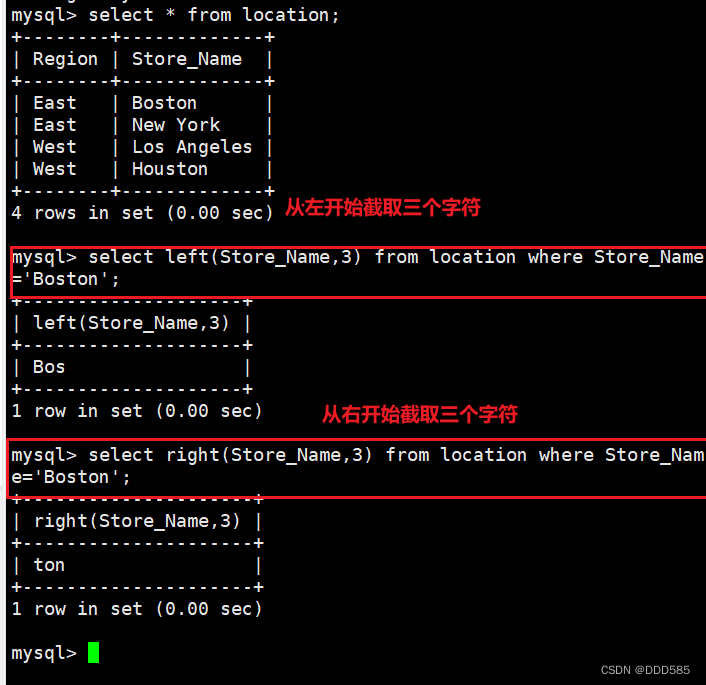
3.查询函数
3.1 group by汇总
group by:对group by后面字段的查询结果,进行汇总分组,通常是结合聚合函数一起使用的
语法:SELECT "字段1", SUM("字段2") FROM "表名" GROUP BY "字段1";
select * from store_info group by Store_Name;
select Store_Name, count(Sales) from store_info group by Store_Name;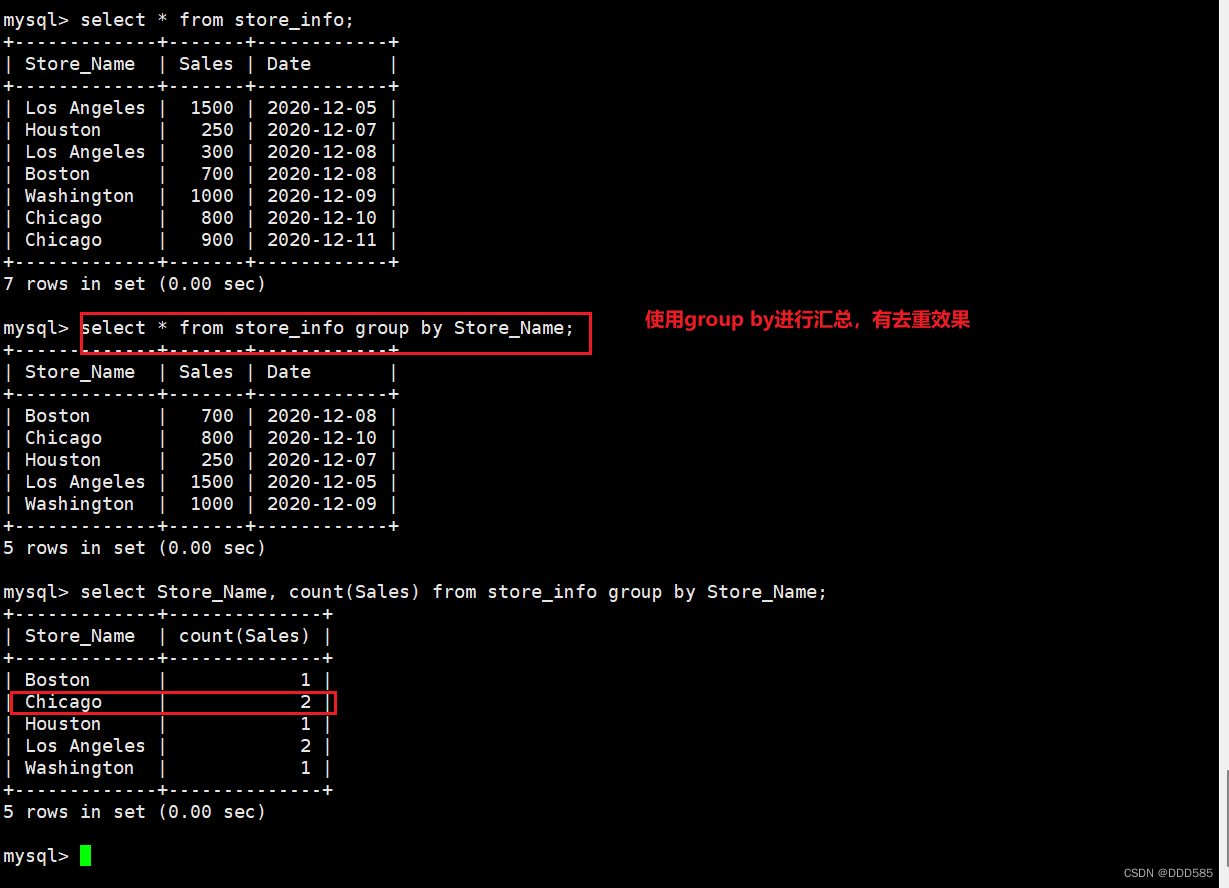
3.2 having
having:用来过滤由group by语句返回的记录集,通常与group by语句联合使用
语法:SELECT "字段1", SUM("字段2") FROM "表格名" GROUP BY "字段1" HAVING (函数条件);
select store_name,sum(sales) from store_info group by store_name having sum(sales) > 1000;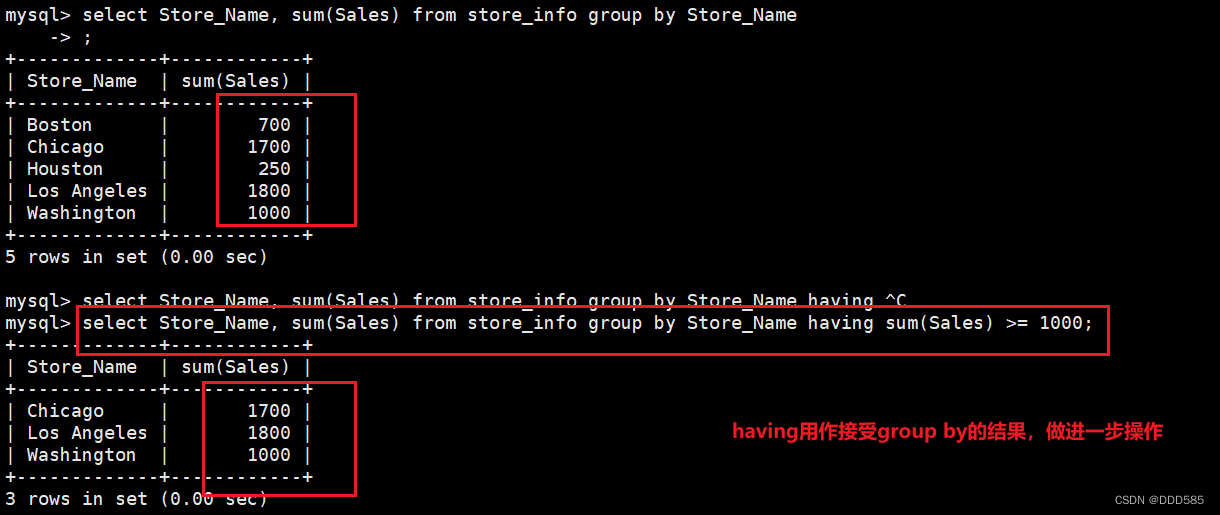
3.3 别名
别名:字段別名 表格別名
语法:SELECT "表格別名"."字段1" [AS] "字段別名" FROM "表格名" [AS] "表格別名";
select A.store_name store,sum(A.sales) "total sales" from store_info A group p by A.store_name;
3.4 子查询
子查询:连接表格,在WHERE 子句或 HAVING 子句中插入另一个SQL语句
语法:SELECT "字段1" FROM "表格1" WHERE "字段2" [比较运算符] #外查询
(SELECT "字段1" FROM "表格2" WHERE "条件"); #内查询
#可以是符号的运算符,例如 =、>、<、>=、<= ;也可以是文字的运算符,例如 LIKE、IN、BETWEEN
select sum(Sales) from store_info where Store_Name in (select Store_Name from location where Region='West');
st');
select sum(Sales) from store_info where Store_Name in (select Store_Name from location where Region='West');
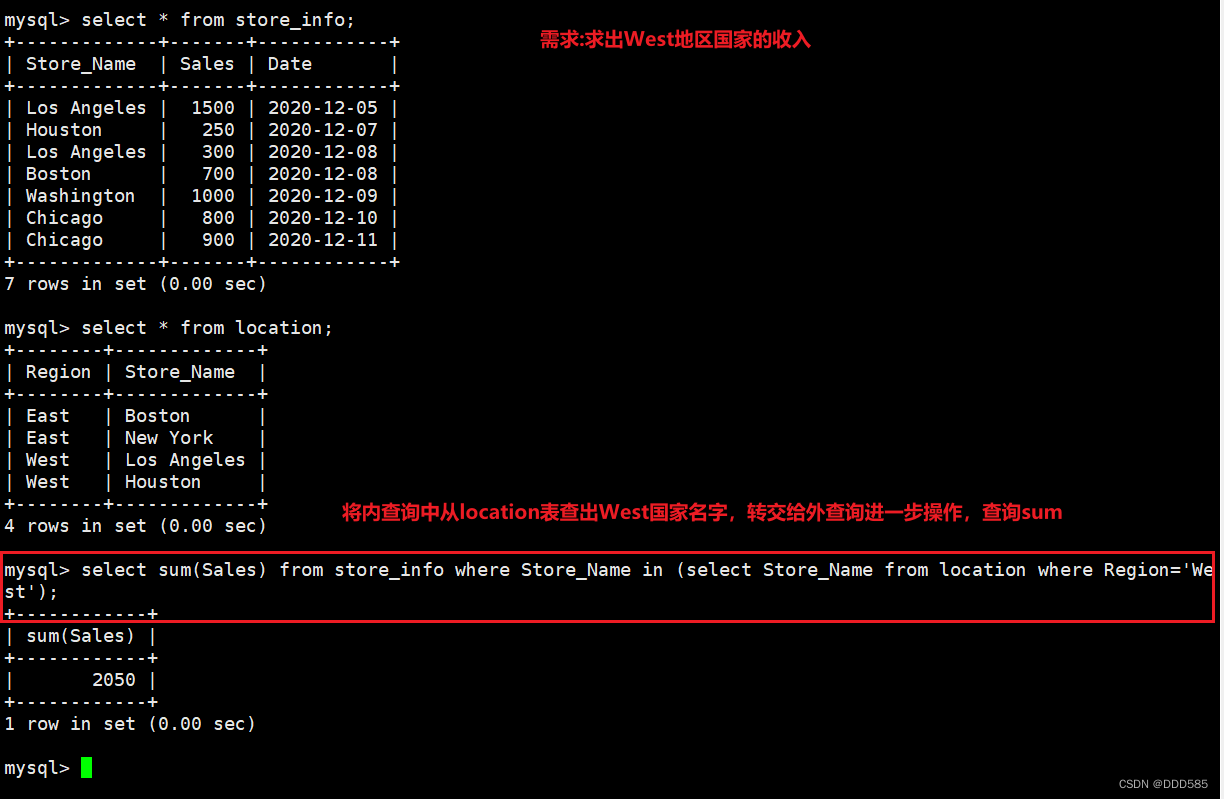
3.5 exists(类查询)
exists:用来根据条件过滤查询结果,并只返回满足条件的行
语法:SELECT "字段1" FROM "表格1" WHERE EXISTS (SELECT * FROM "表格2" WHERE "条件");
#这里的子查询作为条件进行判断。如果子查询返回至少一行结果,则外部查询的结果将包含该行
select * from store_info A where exists (select Store_Name from location B where B.store_name = A.store_name);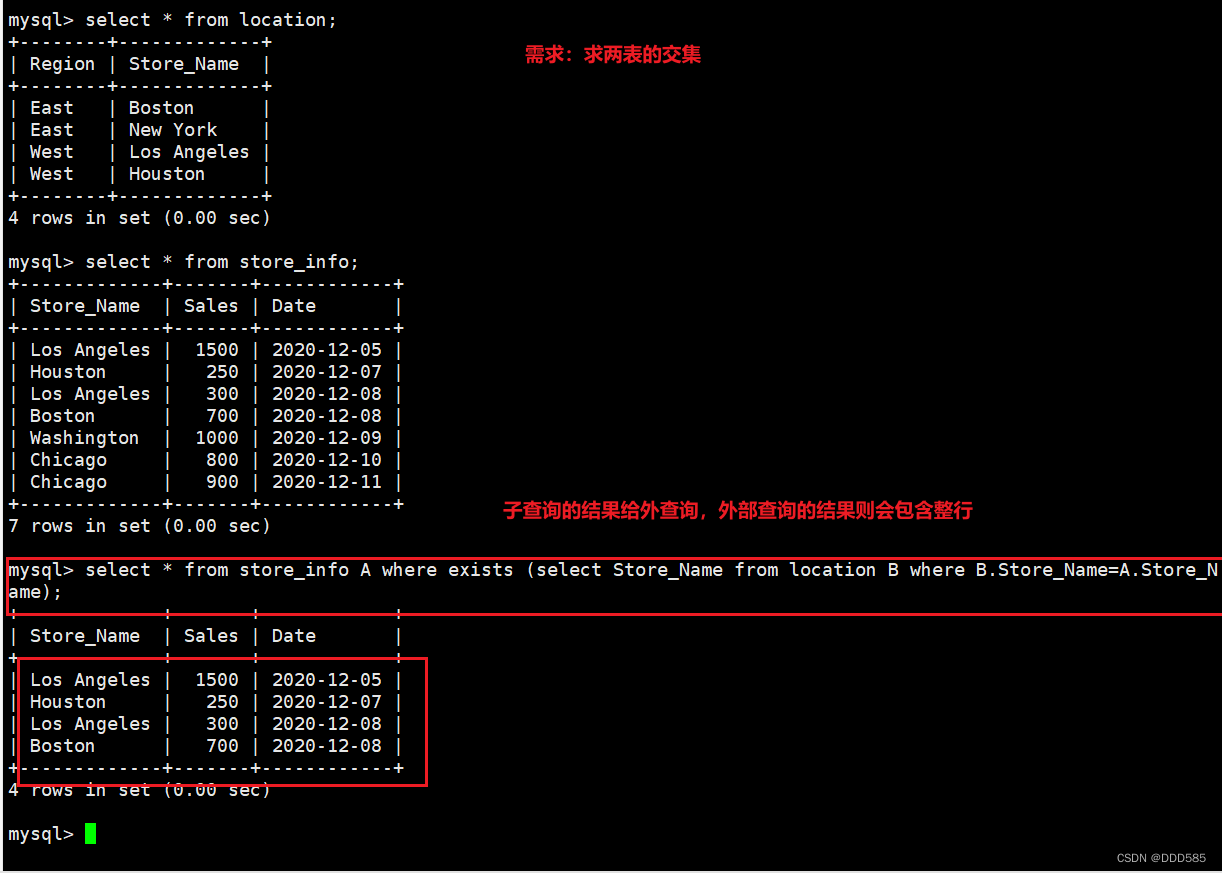
4.连接查询
4.1 表连接
|---------------------|-------------------------------|
| 表连接方式 | 含义 |
| inner join(内连接) | 只返回两个表中联结字段相等的行 |
| left join(左连接) | 返回包括左表中的所有记录和右表中联结字段相等的记录 |
| right join(右连接) | 返回包括右表中的所有记录和左表中联结字段相等的记录 |
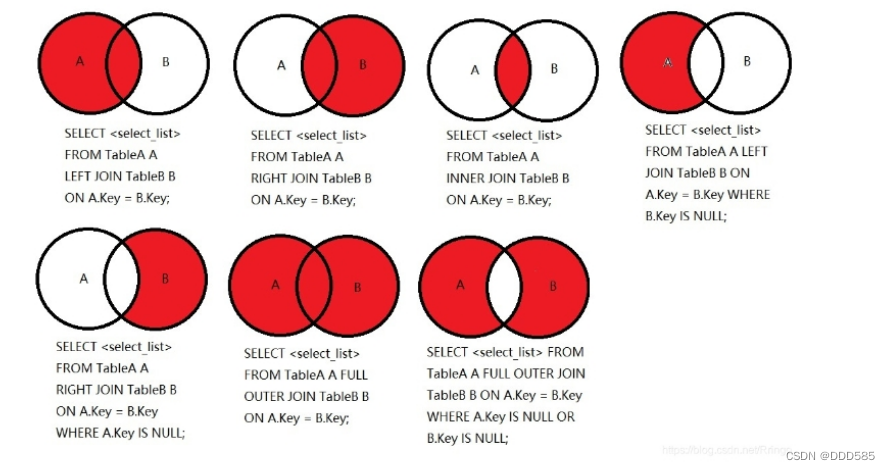
4.2 内连接
select * from store_info A inner join location B on A.Store_Name=B.Store_Name;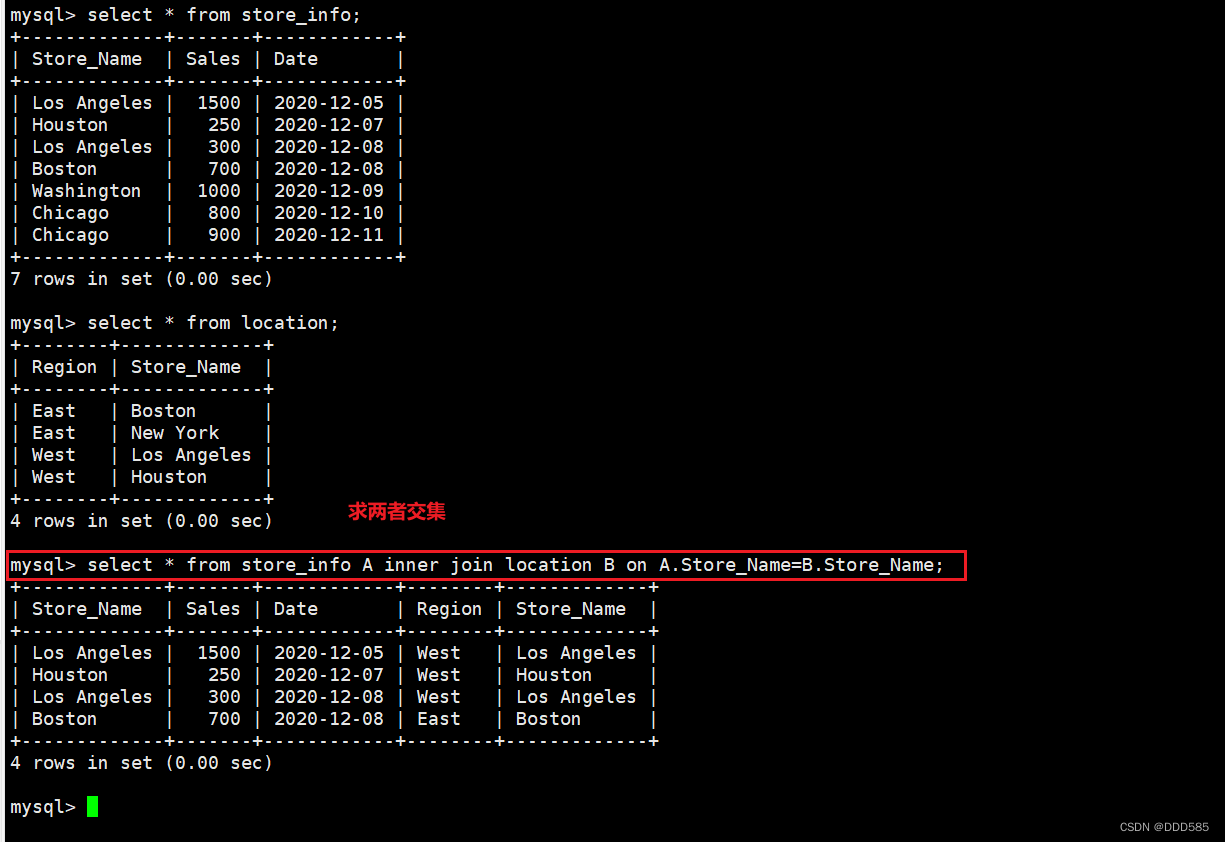
4.3 左连接
select * from store_info A left join location B on A.Store_Name=B.Store_Name;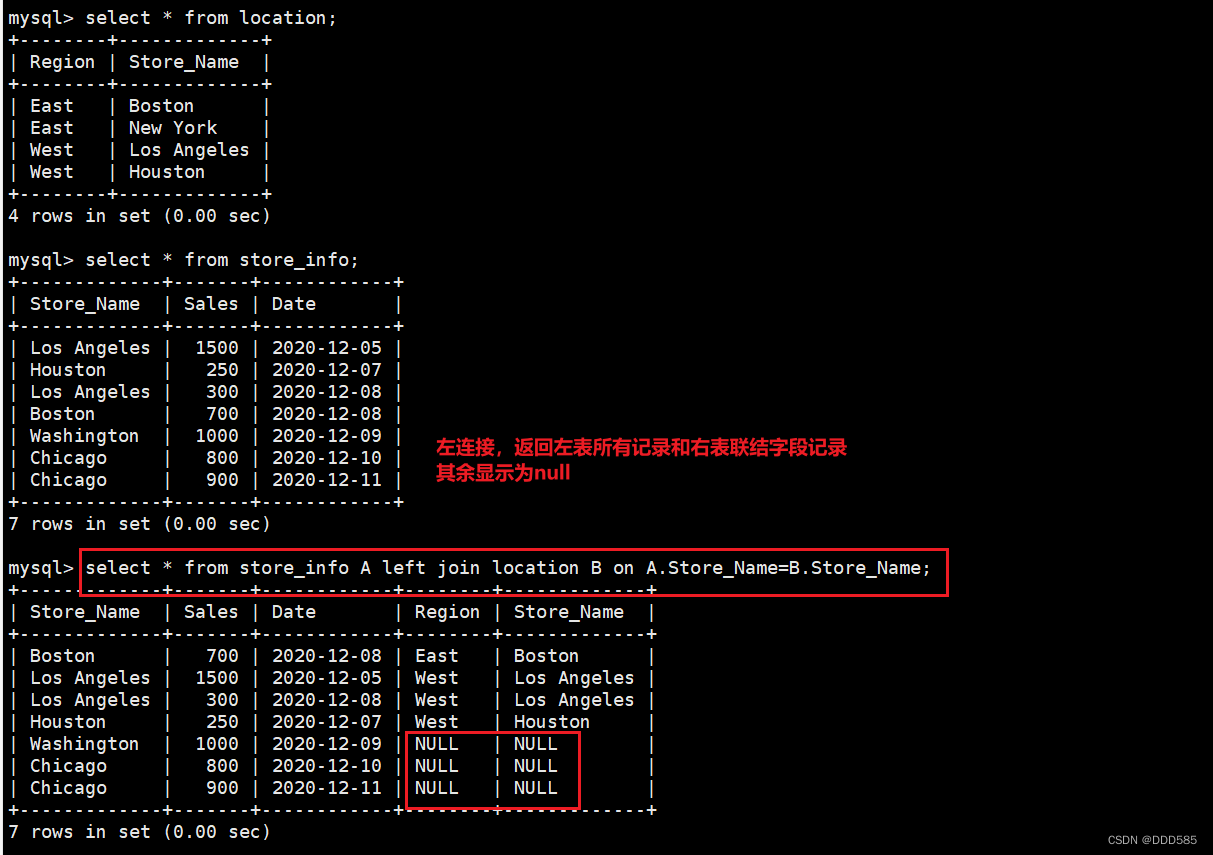
4.3 右连接
select * from store_info A right join location B on A.Store_Name=B.Store_Name;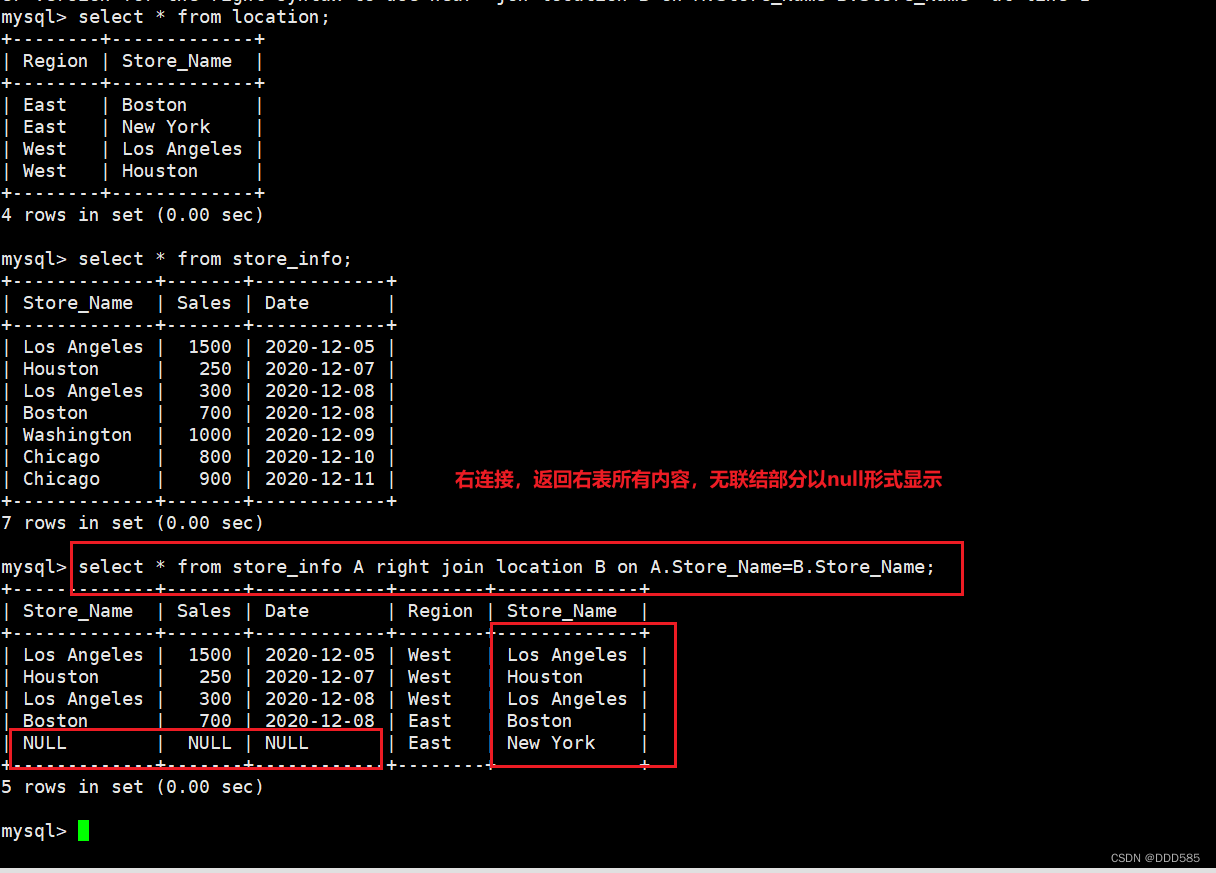
5.求交集、无交集方法总结
5.1 交集方法
1.内连接
select A.Store_Name from store_info A inner join location B on A.Store_Name=B.Store_Name;
select A.Store_Name from store_info A inner join location B using(Store_Name);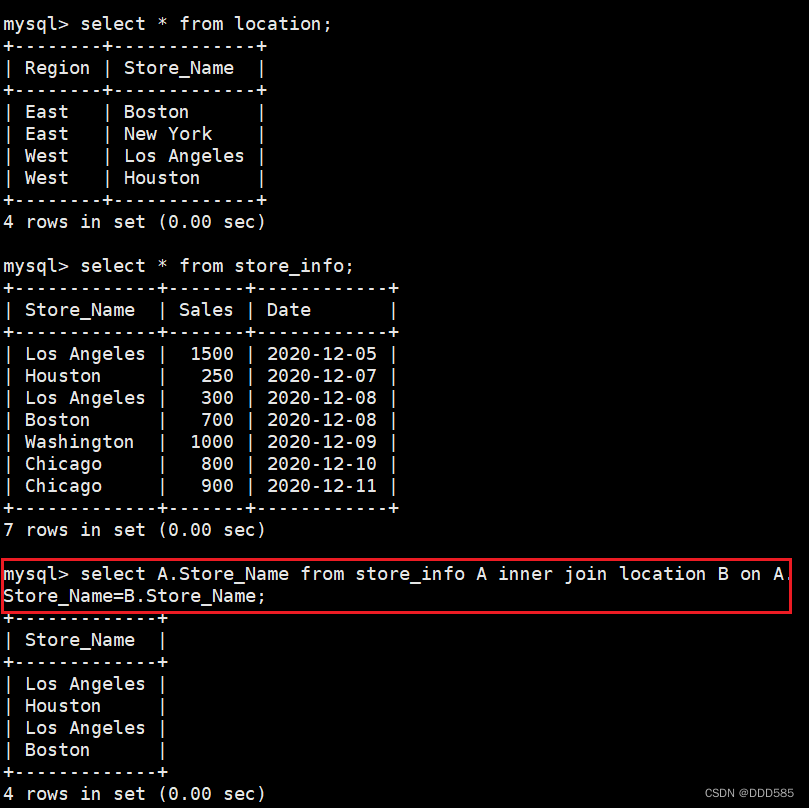
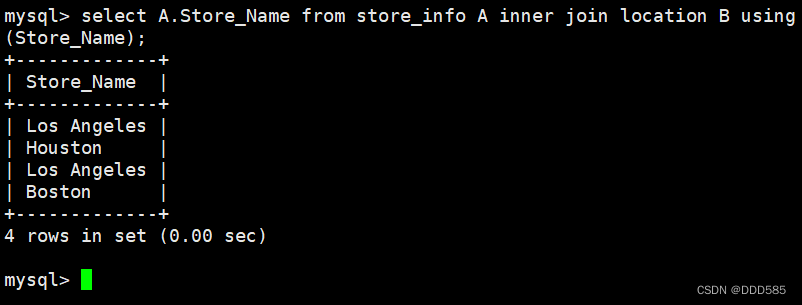
2.左连接
select B.Store_Name from location A left join store_info B on A.Store_Name=B.Store_Name where B.Store_Name is not null;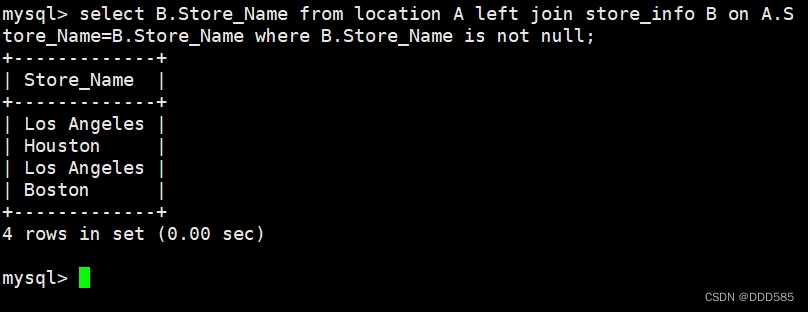
3.右连接
select A.Store_Name from location A right join store_info B on A.Store_Name=B.Store_Name where A.Store_Name is not null;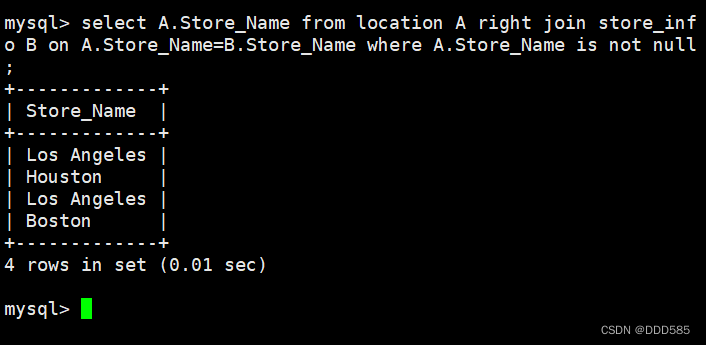
4.子查询
select A.Store_Name from store_info A where A.Store_Name in (select B.Store_Name from location B);
select A.Store_Name from store_info A where exists (select B.Store_Name from location B where A.Store_Name=B.Store_Name));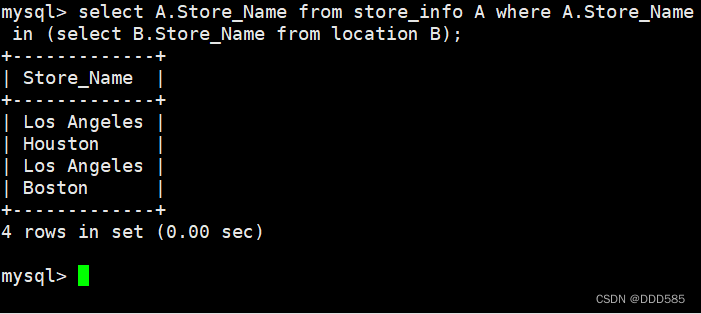
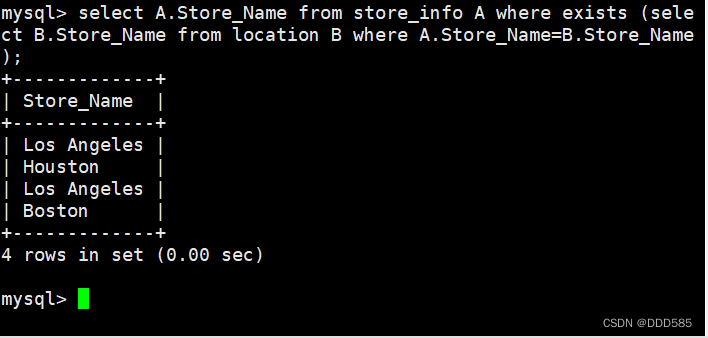
5.多表查询
select A.Store_Name from store_info A, location B where
A.Store_Name=B.Store_Name;
6.联集+分组
select A.Store_Name from (select distinct Store_Name from store_info union all select distinct store_name from location) A group by A.Store_Name having count(A.Store_Name) > 1;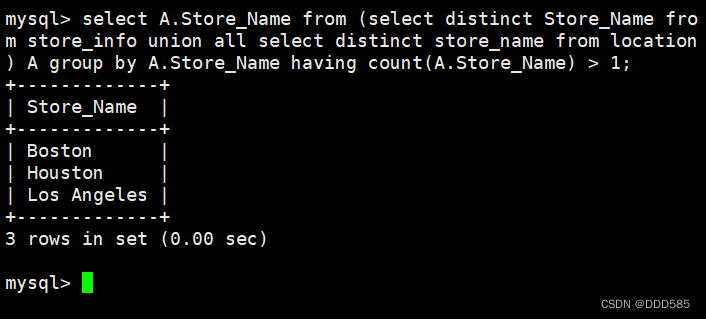
5.2 求无交集方法总结
求左表无交集
select A.Store_Name from location A left join store_info B on A.Store_Name=B.Store_Name where B.Store_Name is null;
select Store_Name from location where Store_Name not in (select Store_Name from store_info);
select A.Store_Name from location A where not exists (sellect B.Store_Name from store_info B where A.Store_Name=B.Store_NName);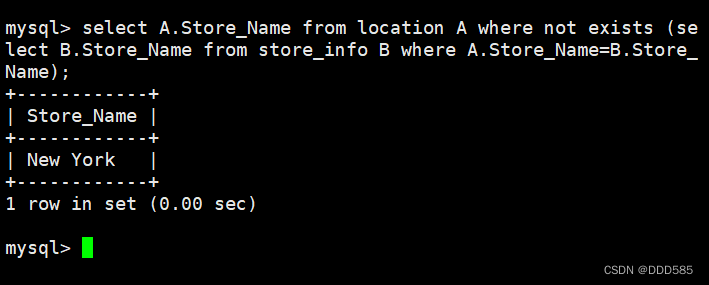
求右表无交集
select B.Store_Name from location A right join store_info B on A.Store_Name=B.Store_Name where A.Store_Name is null;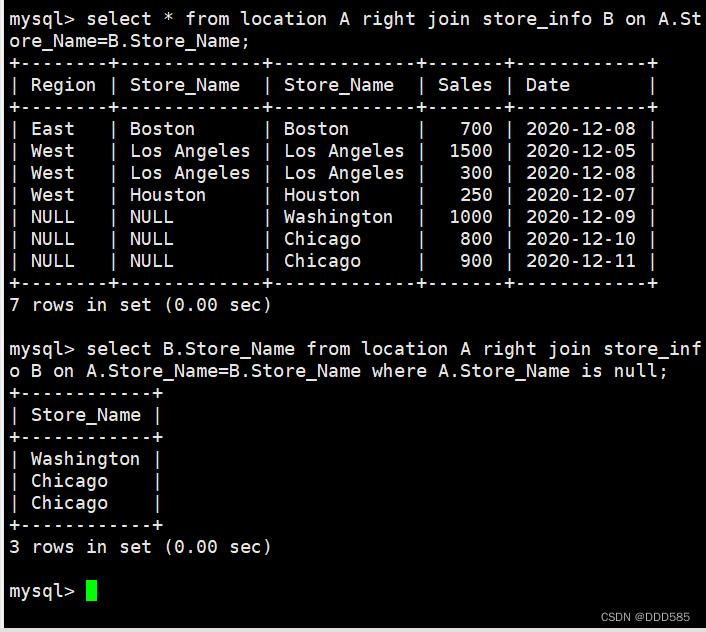
select Store_Name from store_info where Store_Name not in (select Store_Name from location);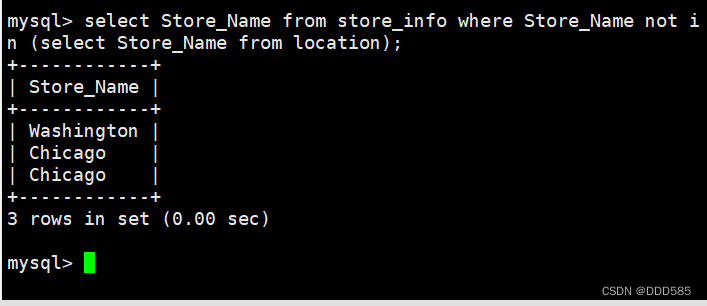
select A.Store_Name from store_info A where not exists (sselect B.Store_Name from location B where A.Store_Name=B.Store_NName);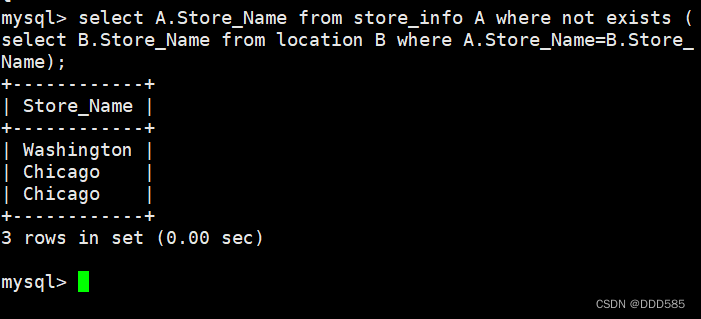
求两个表无交集
select A.Store_Name from location A left join store_info B on A.Store_Name=B.Store_Name where B.Store_Name is null
-> union all
-> select B.Store_Name from location A right join store_infoo B on A.Store_Name=B.Store_Name where A.Store_Name is null;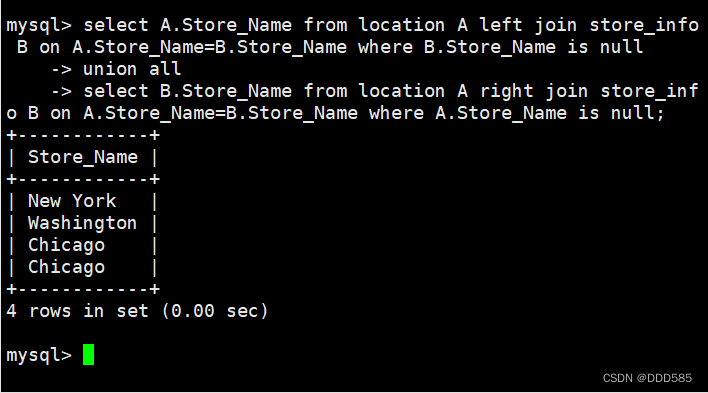
select A.Store_Name from (select distinct Store_Name from store_info union all select distinct store_name from location) A group by A.Store_Name having count(A.Store_Name) = 1;